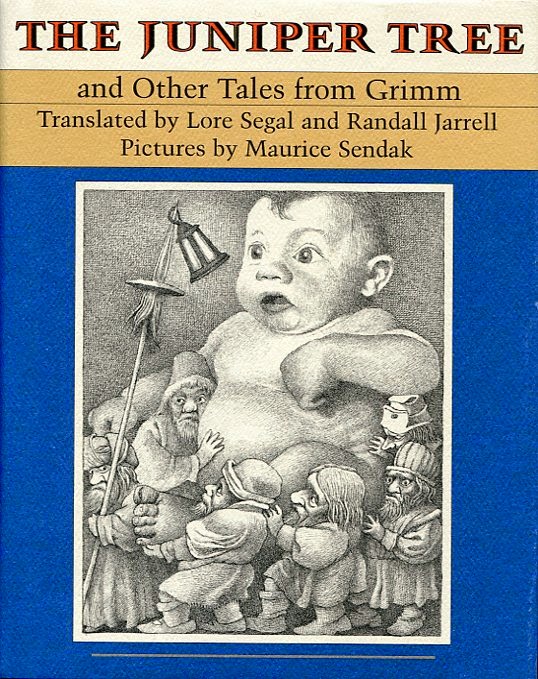WHEN NANCY EKHOLM BURKERT'S picture book Snow-White and the Seven Dwarfs was published in 1972, John Gardner writing in The New York Times said, "People who care about book illustrations have known for some time that one of the best illustrators to be found is Nancy Ekholm Burkert...[and] her new book...transcends her previous accomplishments." He then goes on to say, "Looking at [the illustrations], you wish they were the first pictures you'd seen in your life...Though...I would not wish that the first fairy tale I ever heard was a version by Jarrell. I find his version anything but faithful."
Gardner's harsh criticism, however, must be a minority opinion if the caliber of illustrators who have chosen Jarrell's text is any indication. In addition to Burkert, the legendary Maurice Sendak and the Caldecott-winning illustrator Margot Zemach have also taken turns illustrating the stories that originally appeared in Jarrell's The Golden Bird and Other Fairy Tales. The Brothers Grimms' tales are a children's book illustrator's delight, a chance to showcase her art the way that an actor puts his stamp on Shakespeare. And artists of Burkert, Sendak, and Zemach's stature can take their pick of translations, or even warrant new translations. But all three chose Jarrell, and through his translations created some of their best work.
LONG TIME READERS OF WTWC,MB, will remember how highly I revere Nancy Ekholm Burkert. Snow-White has become her legacy, appallingly the only one of her books (save her most recent) that remains in print. This is because the American Library Association awarded Burkert the prestigious Caldecott Honor for it, recognizing it as one "of the most distinguished American picture books for children."
The book in its first edition was 12.25" x 9.25" making it a little too big for my scanner. So my scans, as it seems are most of the scans available online, are slightly cropped. The good news is that you can easily see the illustrations as they are meant to be seen by buying the book now.
MAURICE SENDAK, who needs no introduction, was Jarrell's primary illustrator, illustrating three of Jarrell's four original children's books. In 1962, when Jarrell turned in his Grimm translations, editor Michael di Capua was so happy with them that he thought about commissioning a larger translation from the poet. di Capua approached Maurice Sendak about illustrating the expanded Grimm, but before the project progressed any further, Jarrell turned in his original story The Bat-Poet. di Capua convinced Sendak to illustrate the new book, and plans for a new Grimm were put on hold. When Jarrell died in 1965, the Grimm book had never begun.

Several years later, Sendak and the Austrian-born author Lore Segal started work on their own Grimm. Growing out of the earlier project, four of Jarrell's five translations were included: "The Fisherman and His Wife," "Hansel and Gretel," "The Golden Bird," and "Snow-White and the Seven Dwarfs."
In his preparatory notes for the illustrations for "The Fisherman and His Wife," (the woman pointing at the rising sun above; right: preliminary sketches) Sendak wrote, "No fish! No hut! No palace! Her à la Grafina Potatska! Yes!" Grafina Potatska, an idiotic Polish count, was what Sendak's mother called his father when she was angry with him. The woman's expression is his mother's. The puppy on the bed is Sendak's golden retriever Io.
Sendak found that the more familiar tales were harder to illustrate. The single illustration for "Snow White" took over six months with several iterations. The illustration for "Hansel and Gretel" took two weeks. His goal with each illustration was "catching that moment when the tension between story line and emotions is at its greatest." For "Snow White," he focused on the conflict between the older generation and the young generation. For "Hansel and Gretel" he tried to capture the moment "the very second before she performs her fearless deed."
There are twenty-three other stories in Sendak's Grimm, entitled The Juniper Tree and Other Tales from Grimm and still in print. Sendak said of the book, "It was a watershed book for me, one that solved a great many technical and emotional problems...a hard job, which took many years of preparation and concentrated effort."
ON MARGOT ZEMACH'S DEATH, Maurice Sendak said, "Margot not only revivified the American picture book, but was one of the very few who helped elevate it to an art form." Awarded the Caldecott Medal in 1974 for her book Duffy and the Devil, she also received two Caldecott Honors in the 1970s. In 1980, Zemach published her rendition of Jarrell's telling of The Fisherman and His Wife. On its appearance, Kirkus Review said, "'If The Fisherman and His Wife' must be illustrated, let it be by Margot Zemach--who has the comic-cataclysmic range, the vigor, the intelligence for the task."
Kirkus comments on Jarrell's translation as well, quoting his "well-chosen words....His is a less patterned telling than, say Wanda Gag's--richer in language, fuller in incident."
All of Zemach's illustrations for the book are brilliant, overflowing with energy and details that make the story her own. Unfortunately out of print, I have posted many more illustrations on my Flickr set here.
IN UPCOMING POSTS, I will further explore Sendak and Jarrell's collaborations as well as work by some of the other artists who have worked on Jarrell's children's books. For background information on Maurice Sendak's work in this post, I consulted The Art of Maurice Sendak by Selma G. Lanes.
All images are copyrighted © and owned by their respective holders.



+-+004a.jpg)
+-+005a.jpg)




+-+003a+-+Copy.jpg)
+-+030a+-+Copy.jpg)

No comments:
Post a Comment